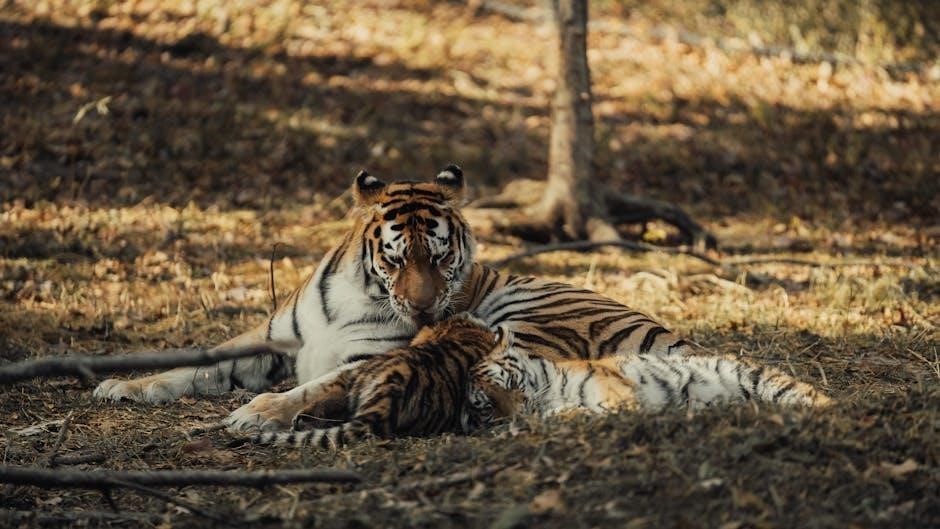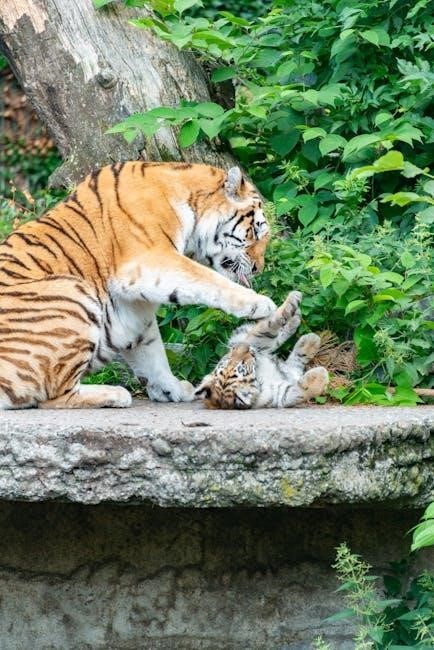Amy Chua’s Battle Hymn of the Tiger Mother sparked intense debate about parenting styles, cultural differences, and child-rearing techniques, offering a provocative look into strict, achievement-oriented upbringing․
Battle Hymn of the Tiger Mother is a memoir by Amy Chua, first published in 2011, that explores her experiences raising her two daughters, Sophia and Lulu, using strict, Chinese-inspired parenting methods․ The book ignited global debate about parenting styles, cultural expectations, and the pursuit of excellence․ Chua details her demanding approach, emphasizing hard work, academic achievement, and musical excellence, while critiquing Western parenting practices․ The memoir also delves into the cultural significance of the “tiger mother” archetype, symbolizing strength, discipline, and high expectations․ Its provocative narrative has made it a widely discussed and polarizing work․
Key Themes
The book explores the clash between Eastern and Western parenting styles, emphasizing strict discipline, high expectations, and cultural influences on child-rearing practices․
Amy Chua’s memoir introduces the idea of the Tiger Mother, a strict, demanding parenting style rooted in Chinese culture․ This approach emphasizes achievement, discipline, and sacrifice, often criticized for its intensity․ Tiger Mothers push their children to excel academically and musically, believing that tough love fosters resilience and success․ Chua’s book highlights the cultural clash between Eastern and Western parenting, sparking debates about the effectiveness and ethics of such methods․ The Tiger Mother represents a blend of high expectations, fierce dedication, and unconditional love, challenging traditional Western notions of parenting․
The Debate Between Eastern and Western Parenting
Amy Chua’s memoir reignites the debate between Eastern and Western parenting styles, highlighting divergent cultural values․ Eastern parents, like Chua, prioritize academic and extracurricular excellence, often through strict discipline and sacrifice, while Western parents focus on fostering creativity and self-esteem․ Chua argues that the Tiger Mother approach, rooted in Chinese tradition, emphasizes hard work and resilience, whereas Western parents may coddle their children, limiting their potential․ This clash of philosophies sparks discussions about cultural identity, parental expectations, and the balance between love and discipline in raising successful, well-adjusted children․

Cultural Context
The book explores traditional Chinese values, emphasizing rigorous education, discipline, and family honor, contrasting with Western parenting’s focus on individualism and self-expression, highlighting cultural differences in child-rearing․
The Role of the Chinese Mother
The Chinese mother plays a pivotal role in shaping her children’s success through strict, demanding parenting․ Amy Chua highlights how Chinese mothers prioritize academic and extracurricular excellence, pushing their children to achieve greatness․ This approach, rooted in cultural values, emphasizes hard work, resilience, and sacrifice for family honor․ The tiger symbolizes strength and power, reflecting the mother’s fierce dedication to her children’s accomplishments․ Chua’s memoir illustrates how this parenting style, though controversial, is deeply ingrained in cultural traditions, aiming to prepare children for a competitive world by instilling discipline and high expectations from an early age․
The Significance of the Tiger Symbolism
The tiger symbolizes strength, power, and fearlessness in Chinese culture, embodying the fierce dedication of a tiger mother․ It represents resilience and high expectations, reflecting the belief that children can overcome challenges with relentless effort․ The tiger mother’s strict approach is not about harshness but about nurturing excellence, pushing children to surpass their limits․ This symbolism highlights the cultural belief in achievement through sacrifice and discipline, making the tiger a powerful metaphor for the demanding yet loving parenting style central to Chua’s narrative․
Parenting Style
Amy Chua’s parenting style in Battle Hymn of the Tiger Mother is marked by strictness, high expectations, and rigorous discipline, reflecting a cultural belief in nurturing resilience and excellence through relentless effort․
Tiger Mothers, as described in Battle Hymn of the Tiger Mother, employ a strict, demanding approach to parenting․ They prioritize academic and extracurricular excellence, often pushing children to their limits․ This method, rooted in cultural beliefs, emphasizes relentless effort and sacrifice․ Chua recounts how she enforced rigorous practice schedules for her daughters, limiting leisure activities․ Critics argue this approach can be harsh, while supporters believe it builds resilience and achievement․ The strictness reflects a deep commitment to preparing children for success in a competitive world, blending high expectations with unconditional love․
Expectations and Achievements
In Battle Hymn of the Tiger Mother, Amy Chua highlights the high expectations Tiger Mothers set for their children, focusing on academic excellence, musical mastery, and extracurricular success․ These expectations are often tied to cultural values of honor and achievement․ Chua’s daughters, Sophia and Lulu, were pushed to excel in piano and violin, showcasing the results of such rigorous standards․ While critics argue this approach may lead to pressure, Chua believes it fosters resilience and accomplishment, preparing children for future challenges and ensuring they reach their full potential in a competitive world․
Battle Hymn of the Tiger Mother by Amy Chua concludes by reflecting on the intense debate it sparked about parenting, cultural identity, and child-rearing․ Chua’s memoir highlights the tension between Eastern and Western parenting philosophies, emphasizing the high expectations and sacrifices made by Tiger Mothers․ While some criticize the strict approach for its emotional toll, others praise its focus on resilience and achievement․ Ultimately, the book challenges readers to rethink their beliefs about parenting, success, and cultural values, leaving a lasting impact on discussions about family and upbringing․
Battle Hymn of the Tiger Mother by Amy Chua is a provocative memoir exploring her strict, culturally driven parenting style, blending humor and honesty to reveal both the rewards and challenges of raising children the “Chinese way․”
Background and Overview
Battle Hymn of the Tiger Mother is a memoir by Amy Chua, first published in 2011, that explores her experiences raising her two daughters, Sophia and Lulu, using strict, traditional Chinese parenting methods․ The book delves into the cultural differences between Eastern and Western parenting styles, sparking widespread debate․ Chua’s approach, characterized by high expectations, intense academic and musical training, and tough criticism, aims to cultivate resilience and excellence in her children․ The memoir includes personal anecdotes, such as the girls’ rigorous piano and violin practices, and their eventual performances at Carnegie Hall, showcasing the rewards of her demanding yet loving approach․

Key Themes Explored in the Book
The memoir explores themes of strict parenting, cultural identity, and the pursuit of excellence, highlighting the tension between Eastern and Western parenting philosophies and their outcomes․
The Concept of the Tiger Mother
The Tiger Mother represents a strict, demanding approach to parenting, emphasizing high expectations, intense discipline, and a focus on academic and extracurricular excellence․ This concept, popularized by Amy Chua, reflects traditional Chinese values, where parents push their children to succeed through rigorous effort and sacrifice․ The Tiger Mother is seen as a symbol of strength and authority, often contrasting with more nurturing Western parenting styles․ Chua’s memoir highlights both the rewards and challenges of this approach, sparking debates about its effectiveness and emotional impact on children․
The Debate Between Eastern and Western Parenting Philosophies
Battle Hymn of the Tiger Mother ignites a fiery debate between Eastern and Western parenting styles․ Amy Chua contrasts the strict, high-expectation approach of Chinese mothers with the more permissive Western style, which prioritizes self-expression and individual desires․ While Eastern methods emphasize hard work, filial piety, and collective success, Western parents often focus on fostering creativity and emotional well-being․ This clash of philosophies raises questions about which approach better prepares children for success and happiness, highlighting cultural values and generational expectations․

Cultural Context and Significance
The concept of the Tiger Mother is deeply rooted in Asian cultural values, emphasizing strength, resilience, and respect for authority, which are central to traditional Chinese upbringing․
The Role of the Chinese Mother in Parenting
The Chinese mother plays a pivotal role in shaping her children’s success through strict, demanding parenting․ Rooted in cultural values of strength and resilience, she prioritizes academic and extracurricular excellence․ By setting high expectations and pushing her children to work tirelessly, she embodies sacrifice and dedication․ This approach, often criticized yet admired, reflects a deep belief in hard work and achievement as the path to prosperity, illustrating the enduring influence of traditional values in modern parenting practices․
Understanding the Symbolism of the Tiger
The tiger symbolizes strength, power, and resilience, embodying the fierce dedication of the Tiger Mother․ In Chinese culture, the tiger inspires both fear and respect, reflecting the strict, demanding parenting style․ It represents a mother’s unwavering commitment to her children’s success, pushing them to endure challenges and achieve excellence․ This imagery highlights the cultural ideals of perseverance and high expectations, central to Amy Chua’s approach in raising her daughters․

Parenting Style and Techniques
Amy Chua’s parenting style in Battle Hymn of the Tiger Mother emphasizes strict discipline, high expectations, and intense dedication to academic and extracurricular excellence, often sparking controversy․
The Strict Approach of Tiger Mothers
Tiger Mothers, as depicted in Amy Chua’s memoir, adopt a demanding and rigorous approach to parenting․ They prioritize academic excellence and extracurricular achievements, often pushing children to their limits․ This method involves intense practice sessions, high expectations, and minimal praise, aiming to foster resilience and success․ Critics argue this approach can be harsh, but supporters believe it prepares children for a competitive world․ The strictness is rooted in cultural values, emphasizing hard work and sacrifice for family honor․ While controversial, this style has produced exceptionally accomplished individuals, sparking debates about its effectiveness and emotional impact․
Expectations and Achievements in Education
Tiger Mothers place extraordinary emphasis on academic and extracurricular achievements, often expecting their children to excel in areas like music, math, and science․ Amy Chua’s memoir highlights the relentless pursuit of perfection, with children pushed to practice instruments for hours and achieve top grades․ This approach is believed to cultivate discipline and a strong work ethic, leading to remarkable success․ While some criticize the pressure, the results often include exceptional accomplishments, such as performances at Carnegie Hall, showcasing the tangible outcomes of these high expectations and dedicated effort․
Battle Hymn of the Tiger Mother by Amy Chua ignites a provocative dialogue about parenting, culture, and success․ Through her unfiltered narrative, Chua challenges Western parenting norms, advocating for an intense, achievement-driven approach rooted in Chinese tradition․ While critics argue the methods are harsh, the book underscores the cultural belief that hard work and sacrifice yield extraordinary results․ Ultimately, it leaves readers contemplating the balance between pushing children to excel and nurturing their individuality, sparking broader conversations about parenthood and cultural identity․
